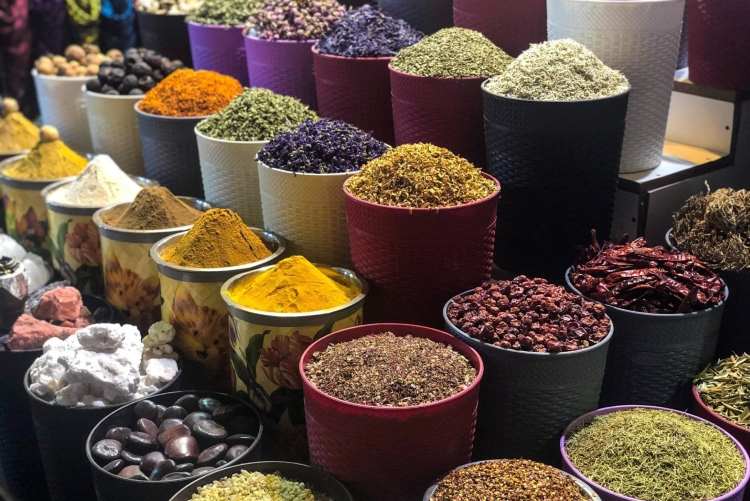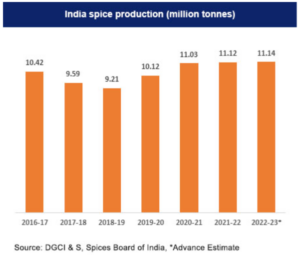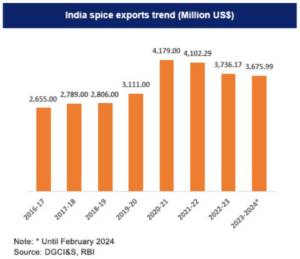
India, renowned for its vibrant and diverse spice markets, stands as the world’s largest producer, consumer, and exporter of spices. However, recent international incidents have cast a shadow over the spice industry’s storied reputation, threatening significant economic fallout and demanding urgent and comprehensive action.
Reports from the United States, Hong Kong, Singapore, Australia, and now the Maldives have raised alarms over the quality of spices supplied by leading Indian firms such as MDH and Everest. The potential economic repercussions are dire, with $2.17 billion—over half of India’s global spice exports—at risk if countries like China and the European Union follow suit in imposing stricter regulations or outright bans due to quality concerns.
This situation is not just about the financial stakes, which are considerable, but also about India’s reputation as a reliable supplier of high-quality spices. The discovery of contaminants like ethylene oxide—a carcinogen—and salmonella in spice consignments has prompted mandatory recalls and increased scrutiny by international food safety regulators.
READ I Govt plans IBC revision to tackle climate change-related bankruptcies


The economic implications of the spice quality concerns extend beyond immediate export losses. Spices play a crucial role in India’s agricultural economy, supporting millions of farmers and workers involved in cultivation, processing, and distribution. A decline in spice exports could lead to reduced incomes in rural areas, exacerbating poverty and economic disparity. Therefore, protecting the spice market is not just about safeguarding exports but also about supporting the livelihood of a significant portion of India’s population.
Lacklustre response from India
The response from Indian regulatory bodies such as the Spices Board and the Food Safety and Standards Authority of India (FSSAI) has been underwhelming, says a brief published by GTRI, a New Delhi-based think tank. Routine sampling and investigations are steps in the right direction, yet they lack the urgency and transparency needed to restore global trust. Erring firms have not faced significant repercussions, which only exacerbates the problem.
For instance, when it was revealed that a significant amount of honey sold in India was adulterated with cheap fructose syrup, the FSSAI intervened to enforce standards. However, the allowance of non-pure labelled products containing additives continues to mislead consumers. This parallels the current spice quality crisis, where terminology and enforcement are lax, leading to potential health risks and a tarnished national image.
Global implications
The implications of this crisis are global in scope. Spices are integral to cuisines worldwide, not only enhancing flavour but also providing health benefits. The quality concerns have already led to bans and increased scrutiny in significant markets, impacting the entire supply chain from farmers to exporters.
India exported $4.25 billion worth of spices in the fiscal year 2024, marking a significant contribution to the global spice market valued at $35 billion. Yet, with such substantial economic interests at stake, the lack of decisive action could destabilise not only domestic markets but also global spice trade dynamics.
The spice quality issue could strain India’s trade relations with key international partners. As countries impose stricter regulations and potentially ban Indian spice imports, it could lead to diplomatic frictions and necessitate complex negotiations to restore confidence. Such geopolitical shifts could also influence other sectors of trade, illustrating the interconnected nature of international commerce and the need for stringent quality controls in one domain to uphold the broader economic relationships.
Way ahead for spice industry
To rectify this, India must implement several critical changes:
Immediate and transparent actions: Swiftly investigate and publicise findings regarding spice quality issues. This includes holding companies accountable and ensuring that penalties and corrective actions are well-publicised and enforced.
Strengthen regulations and enforcement: Review and enhance the regulatory framework governing spice quality. This includes regular and rigorous inspections, not just reactive measures following international incidents.
Enhance communication and education: Both domestically and internationally, stakeholders must be kept informed about standards, issues, and actions. Clear and continuous communication is essential to rebuild and maintain trust.
Invest in technology and infrastructure: Modernise testing facilities and invest in technologies that can detect contaminants and ensure compliance with international safety standards.
To address these challenges effectively, India must leverage technological advancements in quality assurance processes. The adoption of blockchain technology for traceability, AI-driven quality control systems, and IoT for real-time monitoring of spice processing and storage conditions can revolutionise how quality is managed. These technologies not only enhance the ability to monitor compliance but also increase transparency with international buyers, showcasing India’s commitment to high standards.
India’s spice industry, a vital component of its agricultural export sector, is at a crossroads. The country can either take decisive action to address these quality concerns and enhance its regulatory frameworks or risk losing its prestigious standing in the global market. The choice is clear, and the time to act is now, to ensure that the legacy of India’s fabled spice garden remains untarnished and continues to thrive in the global culinary landscape.
